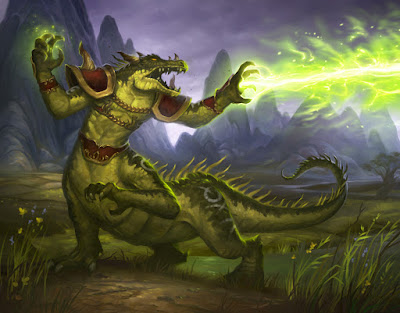As monsters raise their not-so-comely heads from the murk of faraway wilderness, the opportunity to peer at different regions of Calidar presents itself. Here’s an example. Let me know if you want more of this. Monster stats are written for D&D BECMI. If you’re not into Calidar, feel free to cannibalize. A nasty critter is a nasty critter, no matter the chosen game world.
 |
| Artwork by Howard Lyon via Muddy Colors ©2015 Blizzard Entertainment (presumably) |
Crocotaur: AC 3 (unarmored), HD 8****, 40 hp, MV 90’
(30’)/90’ (30’) swimming, AT 1 bite/4
claws/1 tail or 1 spell, D bite 2d8/claws 1d6 each/tail 2d6 or by spell,
Save F8, Str 16, Dex 9, Int
8-10, Wis 9-13, ML 10, AL Chaotic,
Size: L (10’+ tall, 3,000 Lbs.) XP 2,850.
Abilities: Spellcasting as a
Level 6 Cleric—Levels I-II x2 each, Level III x1. Night vision, detect drawn blood within
a 300’ radius; sense movement underwater within 30’ radius; bite lock (see
description); surprise a foe near the water’s edge with a roll of 1-2 on a d6 when attacking from beneath
the surface.
A demigod
known as Dramongul once attempted to establish a swamp realm on Calidar, along the Sea of Gormon's eastern coast. Part lizardman and crocodile, Dramongul’s
people are well adapted to their natural environment. Successful at first, they
triggered their civilization’s doom after disturbing the Dread Lands and
attempting to fight back. Challenged by colossal forces of nature, Dramongul fled
the prime plane. With their dark temples ruined and their kind nearly wiped
out, survivors found refuge on two swampy islands near the coast, each about 140 miles across. Partially submerged, their fortified dwellings hide under the canopy of mosquito-infested, mossy jungle. They form two rival kingdoms blaming each
other for the demise of their once-powerful theocracy. Each side also holds a piece
of an artifact that could weaken the Dread Lands enough to enable reestablishing the old
theocracy, if ever they were reassembled. With neither side wishing to relinquish its sacred relic, a state of
war prevails among the two neighboring islands.
Their
dwellings are typically unlit and consist of partially flooded chambers and
underwater corridors. Entrances are usually located beneath the surface. Crocotaurs
can stay submerged up to 30mn if active, or 2 hours if hiding or lying in ambush.
Their writing consists of claw-engraved bones, calabashes, and soft stones.
Such engravings can be their version of clerical scrolls. Crocotaurs know how
to brew potions and other potent beverages. They dislike fire and fear
lightning bolts (–2 penalty to their Morale checks if one is cast at them).
If its
damage is average or better, a bite is strong enough to lock on to its prey. To release its hold, the crocotaur must be killed or made to fail a
Morale check and flee. A locked bite automatically inflicts 1d6 damage per
turn; it enables the crocotaur to drag a man-size victim underwater (moving 20’
per round on the ground or at full speed underwater), and bestows a +2 bonus to
hit with its four front claws. The tail attack can only reach foes behind or
beside the creature; if incurring average or greater damage, its victim must
succeed a saving throw or be stunned (effect: move at 1/3 MV, can’t attack or
cast spells, –2 penalty to both AC and saves). Unencumbered crocotaurs can run
at 90’/round when on solid ground.
Some favor
combat equipment when fighting on the ground, such as woven-bamboo tusked shields,
bone helmets adorned with monstrous horns, javelins (2-3 strapped on back), or
melee weapons made of ironwood (a cleaver or a fang-studded mace).
Shield-bearing crocotaur’s are AC 2. Their tusked shields can inflict 1d6+2
damage (on shield-bearing side only); melee weapons inflict 1d8+2 damage;
javelins are usually thrown (range: 30/60/90) and inflict 1d6+2 damage. All physical
attacks are held back and weapons set aside when casting spells. Crocotaurs
aren’t known to use bows and other non-thrown missile weapons, but may
nonetheless produce magical equipment of a clerical nature.
Source Material:
The geographic chart was cropped and altered from the climate map in Calidar’s
CAL1 “In
Stranger Skies,” pg. 71. The demigod came from the list of monstrous
deities in CC1 “Beyond
the Skies,” pg. 241. The crocotaur itself is original content developed for
the author’s blog.

No comments:
Post a Comment
Note: Only a member of this blog may post a comment.